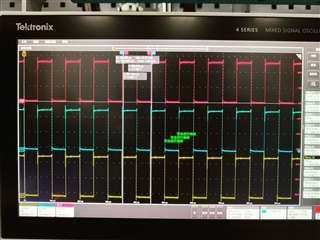Other Parts Discussed in Thread: UCC27201A, UCC27201
Hi team,
Here's an issue from the customer may need your help:
As shown in Figure 1 below, the UCC27201A drives a 24-V 3-phase BLDC motor, where the DC 24 V is controlled by controller via a PMOS switch:

The PMOS switch has a large resistance of 3K in parallel with the D/S, and the drive waveform of U/V/W when the motor is not operating is shown in Figure 2 below. At this point, the switch PMOS is turned off, and the U/V/W drive voltage is only about 13 V after all the 3K resistor divider in parallel with the PMOS.

The U/V/W drive waveform with PMOS off and motor not operating is as follows:

What are the benefits of this design? Why pre-add U/V/W in-phase weak voltage drive when the motor is not operating?
Could you help check this case? Thanks.
Best Regards,
Cherry

